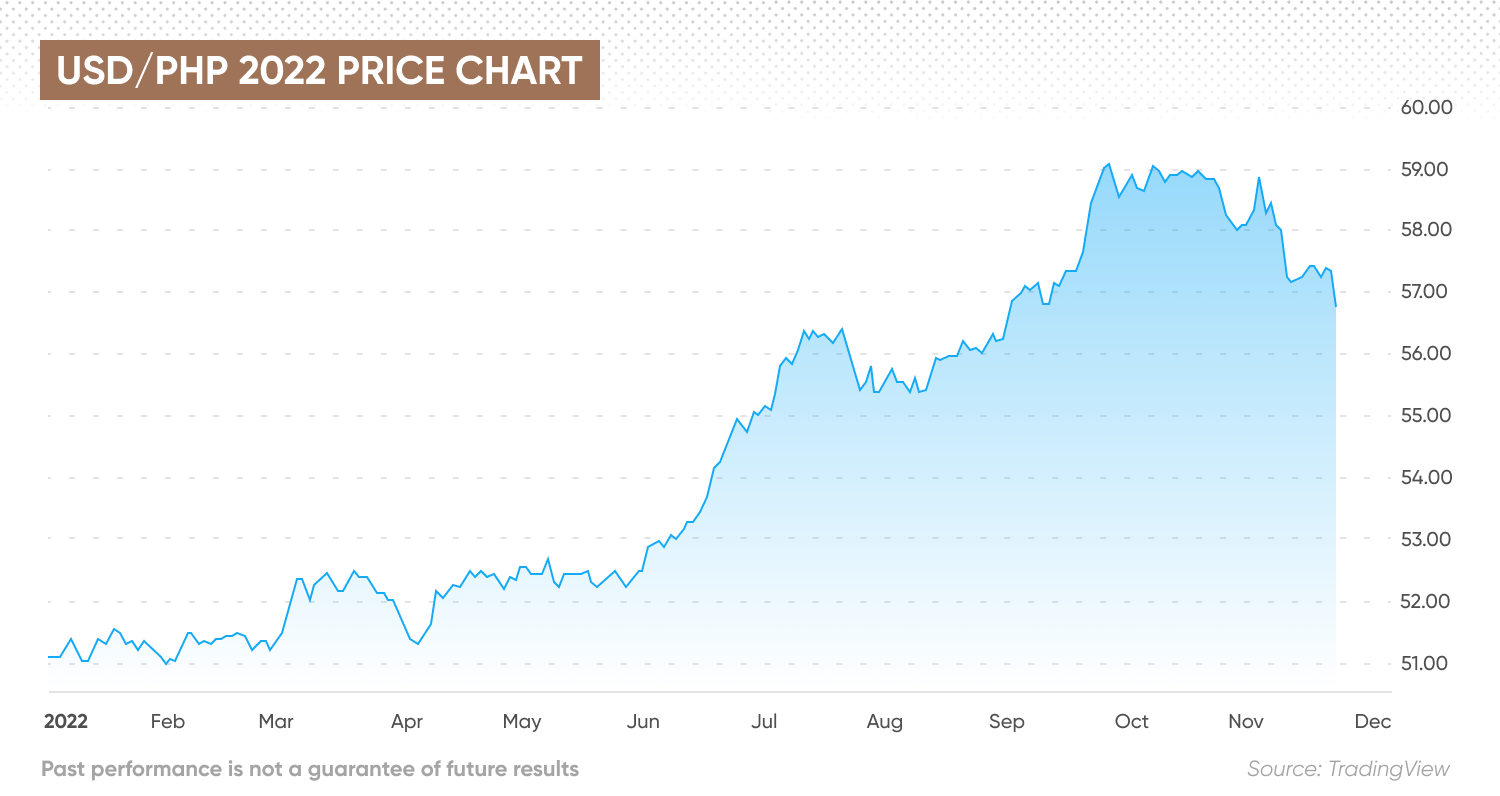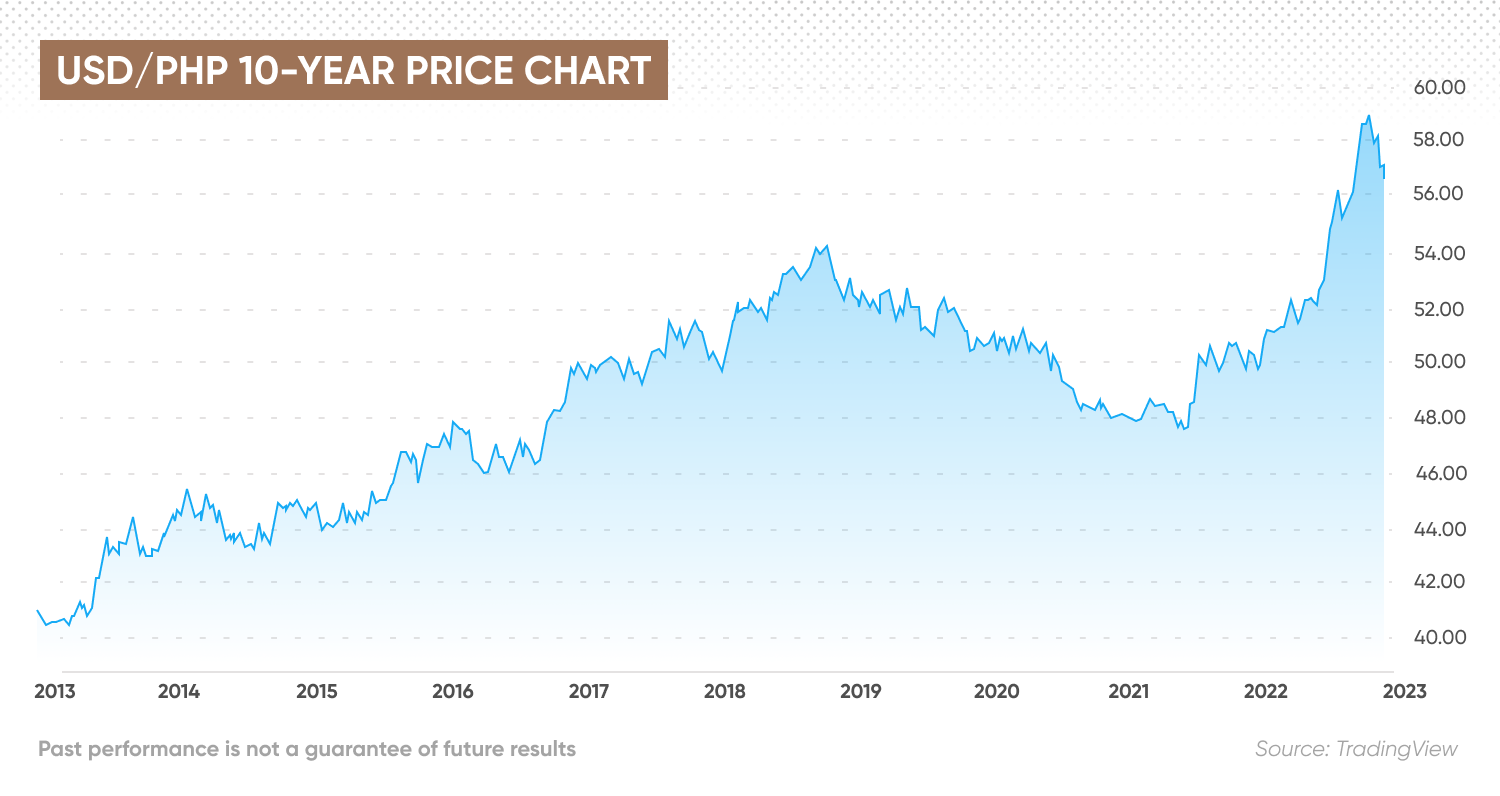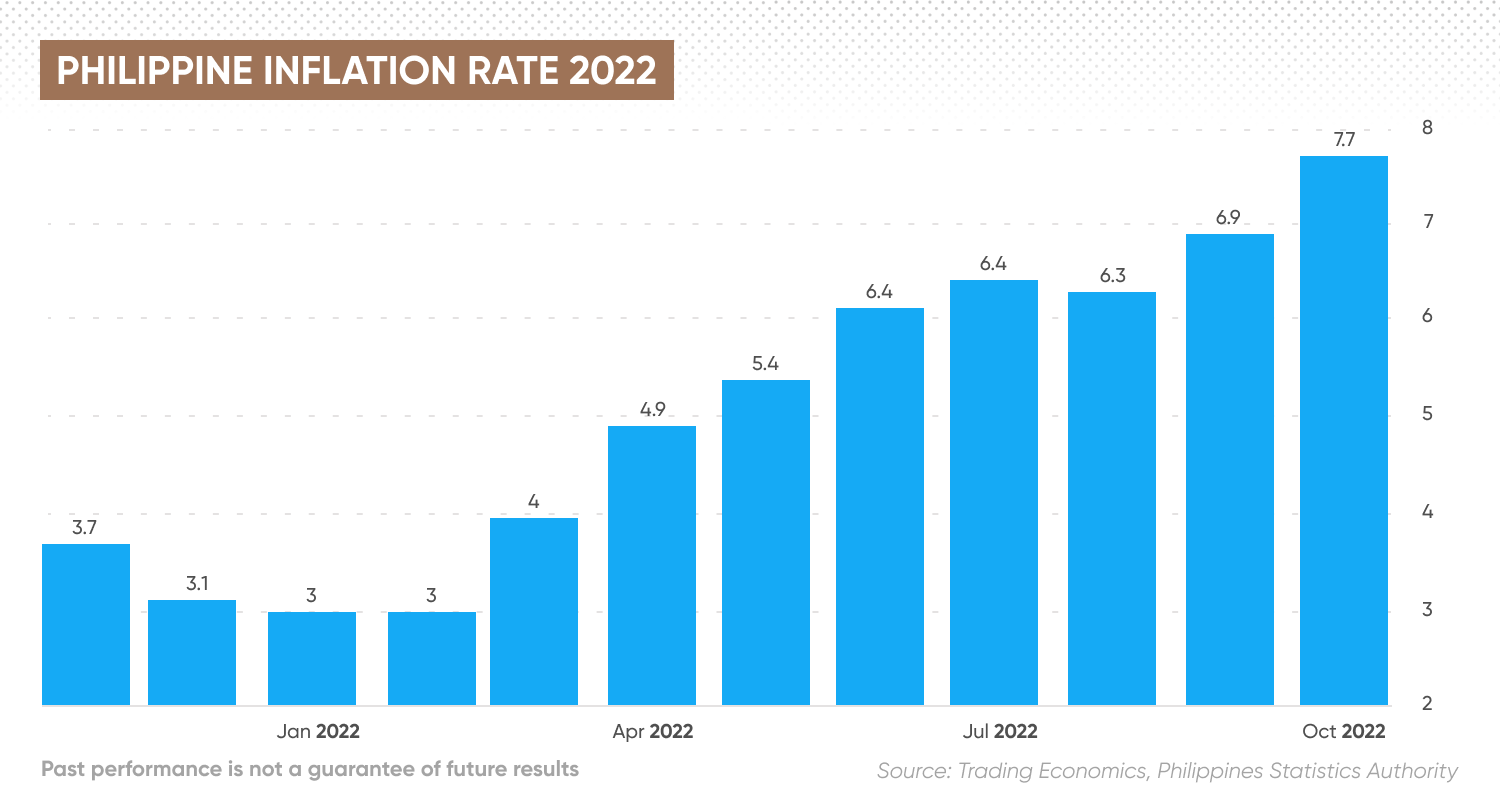USD/PHP forecast: What lies in store for the currency pair?
The Philipinne peso has rose to a two month high against the US dollar in September, is this the start of a new trend?
After rising to an all-time high against the US dollar (USD) in September 2022, the Philippine peso (PHP) has fallen slightly in 2023. Year-to-date the PHP has dropped -0.58% aganist the USD.

Here we look at the latest moves in the Philippine peso, Southeast Asia’s world performing currency this year, what fuelled those moves and analysts’ US dollar to Philippine peso forecasts.
What is the Philippine peso?
The Philippine peso (PHP), is the national currency of the Republic of the Philippines. The currency was pegged against the US dollar until 1993, when the New Central Bank Act of 1993 set the peso on route to becoming a free-floating currency.
A free-floating exchange rate means that the value of the PHP is determined by the interbank foreign exchange markets, in other words, by supply and demand. This means that if more Philippine pesos are demanded than offered, the price of the peso would rise and vice versa.
What is USD/PHP?
The exchange rate USD/PHP tells us how many Philippine pesos equal one US dollar. For example, if USD/PHP was 59.00, this means that 1 USD is equivalent to 59 Philippine pesos.
What influences the Philippine peso?
As with many currencies, the value of the peso depends on central bank action, raising or lowering interest rates. The central bank considers growth, inflation rates, and the trade balance, among other economic factors, to set monetary policy.
In addition to addressing interest rates, the Philippine Central Bank can intervene in the forex market to curb excess volatility and stem depreciation or appreciation of the PHP, if deemed necessary.
The trade deficit and central bank reserves can influence the value of the Philippine peso.
As well as the PHP, the value of the USD is also relevant, and whether the US Federal Reserve (Fed) is hiking or cutting interest rates can also influence the exchange rate.
USD/PHP price history
USD/PHP has been steadily climbing since early 2013, when the pair traded at 40.00.
By 2015, the peso had weakened to 45.00 against the dollar, and the pair reached 50.00 in early 2017.
From there, USD/PHP climbed to 54.40 in October 2018, before the Philippine peso strengthened again, taking the pair to 47.70 in June 2021.
From this five-year low, USD/PHP climbed sharply higher across 2022, hitting an all-time peak of 59.21 on 28 September. Since then, the pair has fallen lower, starting 2023 at 55.70 and standing at 55.98 as of 17 April 2023.

Latest Philippine peso developments
 The Philippine peso has remained at relatively consisent levels so far in 2023. However, weakness could persist amid a widening trade deficit as interest rates increase, which, combined with rising inflation, could hurt consumer demand and growth prospects.
The Philippine peso has remained at relatively consisent levels so far in 2023. However, weakness could persist amid a widening trade deficit as interest rates increase, which, combined with rising inflation, could hurt consumer demand and growth prospects.
The Philippine Statistics Authority reported on 7 March that the country's headline inflation rate marginally slowed down to 8.6 percent in February 2023 from 8.7 percent in January 2023, as price increases of certain food commodities and energy eased.
As a result, the Philippine central bank stayed in an inflation-fighting mode in March, raising its benchmark interest rate by 25 basis points to 6.25%, but said its next policy decision will depend largely on how consumer prices behave in the coming months.
The Philippines has experienced one of the fastest rates of inflation in Southeast Asia at 8.7%, which comes as the peso is one of the worst-performing currencies in the region.
The Philippine central bank, the Bangko Sentral ng Pilipinas (BSP), has hiked rates by 375 basis points (bps) since June 2022, to cool inflation and support the peso. Given that the Philippines is very dependent on imported food and energy, a weak peso can raise imported inflation, making the economic backdrop worse.
At the most recent monetary policy meeting in February, the Philippine central bank raised interest rates by 50 bps, taking the overnight rate to 6% – its highest level in 15 years.
BSP governor Felipe Medalla has vowed to match any move by the Fed in the coming months and maintain a 100 bps differential with the Fed fund target rate.
The weaker peso has meant that the cost of importing staples such as fuel and rice has surged, lifting inflation to its highest level since December 2008. Rising commodity prices have also widened the trade deficit to a record level.
According to the BSP, the trade balance and current account are expected to remain in deficit in 2023. The BSP forecast the trade balance could widen to $19bn in 2022 and $20bn in 2023.
Economic growth in the Philippines was strong in the first half of 2022, boosted by the economy reopening after the Covid-19 pandemic and election-related spending. However, in the year’s second half, the economy experienced more headwinds as soaring inflation and rising borrowing costs weighed on growth.
Analysts at ING forecast inflation could remain at 5.6% in 2022 and 5% in 2023. This could translate to growth of 5.9% in 2022 and 4.4% in 2023.
Recent USD decline
The USD has fallen steeply in recent months after inflation in the US started to cool. The US March Consumer Price Index (CPI) rose 5.0 percent from a year earlier, easing from a 6.0 percent advance the month before and missing market expectations forecasts of a 5.2 percent increase. The headline inflation eased for a ninth consecutive month to the lowest level since May 2021, led by a sharp decline in the cost of energy.
On 22 March, the Federal Reserve announced that it's raising interest rates by 0.25 percentage point, following its March 21-22 meeting, bumping the federal funds rate to a target range of 4.75 to 5.0 percent.
But investors are growing increasingly convinced that the Fed could start slowing the pace of rate hikes. The US dollar index (DXY), which measures the dollar against a basket of major peers, has fallen almost 1.24% YTD.
The weaker USD and slower expected pace of hikes take the pressure off other global central banks to raise rates as aggressively.
US dollar index (DXY) live chart
USD/PHP forecast
As of 28 November, analysts at Trading Economics, in their USD/PHP forecast, expected the pair to strengthen. They forecast the pair could be at 56.09 by the end of the current quarter and 57.89 in 12 months.
According to ANZ Research, The peso is likely to face less choppy waters in 2023 after emerging as one of the worst performing currencies in Asia this year when the external position of the Philippines deteriorated significantly.
ANZ Research said: “Ready to Rebound Even if Growth Slows.”
ANZ reserach forecast that the peso is seen strengthening steadily to 55.50 in June 2023, then to 55.20 in September and 55 in December. The appreciation would extend to 54.80 in March 2024 to 54.60 in June, 54.40 in September and 54.20 by end-December 2024.
The USD/PHP prediction from algorithm-based forecaster Wallet Investor also forecast that the peso could strengthen. It had USD/PHP ending this year at 57.445. In the longer term, its US dollar to Philippine peso forecast for 2025 saw the rate rising to 61.674 by the end of the year.
In contrast, algorithm-based service AI pickup’s USD/PHP forecast for 2025 saw the currency strengthening to 51.03 that year. The service’s USD/PHP forecast for 2030 saw the peso strengthening to 48.96.
Analysts at ING also saw the Philippine peso strengthening over the longer term. However, they forecast that USD/PHP could fall to 52.50 in the second quarter of 2023, before steadily rising to 51.50 by Q4 2025.
Meanwhile, a senior analyst at MUFG, Jeff Ng, was more upbeat about the economic outlook for the Philippines, forecasting economic growth of 7.5% to 8%.
Ng told a press conference that he expected the factors that affected growth, such as high inflation, a wider current account deficit, and a weaker peso, would likely normalise next year. He predicted the BSP end rate at 5.5% by the end of December, with no more BSP hikes next year.
Ng also said in the previous P61 to the US dollar forecast under review after the recent US dollar weakness, which has allowed “scope for stability around current levels close to P57”.
Note that analysts’ predictions can be wrong. Forecasts shouldn’t be used as a substitute for your own research. Always conduct your own due diligence before trading. And never invest or trade money you cannot afford to lose.
FAQs
Why has USD/PHP been dropping?
USD/PHP has fallen from its September 2022 high as inflation in the US cools, and the US Federal Reserve (Fed) looks towards slowing the pace of rate hikes. The PHP has hiked interest rates to a 15-year high.
Will USD/PHP go up or down?
Where the USD/PHP pair goes from here could depend on the actions of the BSP and the Fed. This could influence USD/PHP if central bank policy divergence grows. Should Philippine economic growth slow considerably, the peso could struggle.
When is the best time to trade USD/PHP?
The best time to trade USD/PHP is usually between 12:00 and 15:00 GMT, when the market is most liquid.
Is USD/PHP a buy, sell or hold?
Whether you think USD/PHP is a buy, sell or hold is a personal decision. Remember to do your research, considering each country's economic outlook, GDP, imports, exports, inflation data, commodity prices, and foreign exchange reserves. And only invest what you are comfortable losing.